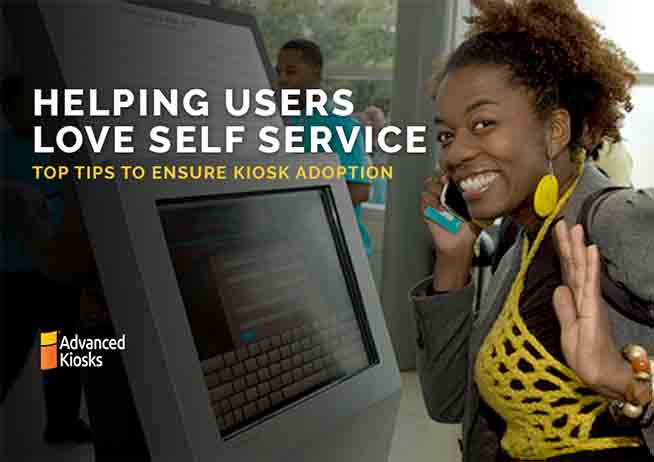It’s pretty common for people to be reluctant to change in general and adopting self service is no exception. Some are put off by the idea at first because they don’t know how to use the kiosk, they may think it is difficult to manage, and they don’t want to change their daily schedule. The irony is, once they get over that first step, the benefits start to emerge and quickly becomes the new norm.
Feedback shows us, there are a few things that can be done to ease people through this transition and make that initial interaction easy and quick.
Messaging and Signage for the Kiosk
Make it clear to users what the kiosk is there for. Apply graphics on the kiosks and utilize the screen to engage and invite users. Using signage nearby to direct users to the kiosk is essential depending upon the location of the kiosk within a business or facility. The signs can show step by step use of the kiosk, smiling faces of people using a kiosk, a video of a person explaining why self-service technology is useful and efficient, etc. Help the customers see the difference self-service technology can make.
Position Staff Near the Kiosk
When possible, having staff stationed in the vicinity of the kiosk to support and assist users can be effective. This can be done temporarily to get users accustomed to the change and also demonstrate that kiosks are not taking jobs away but are allowing staff to work on other, more challenging tasks.
Give Rewards or Incentives for Using Kiosks
Above and beyond enjoying shorter wait times, you can offer incentives to users that utilize the kiosks. Create programs and promote discounts, coupons, or small giveaways. Small incentives will cost the organization very little while making a huge positive impact on the user’s satisfaction and increase the value of your self service investment.
Kiosk Software and Ease of Use
Most of all, invest in a solution with a well designed interface and kiosk software that is simple, clean and easy to use. A familiar, intuitive, interaction with the kiosk is a winner every time. If the customer experience is confusing or the kiosk hardware or software does not perform well, it will be difficult to get users to come back for more. Some things to keep in mind when assessing the user’s experience:
- Speak Their Language: Keep the language used for options and instruction easy for all users to understand
- Keep it Simple: Make sure the primary tasks for the kiosk are easier for the user to achieve on the kiosk
- Current Info: The kiosk system you choose should be easy to regularly update so the information is always fresh and accurate
- User Feedback: Provide a means for users to let you know what went well and what didn’t so it can be improved
- Kiosk Usage: Select a kiosk system that logs user interaction to monitor the success and adoption rate
- Invest in Quality: This one seems obvious but is most important, do the homework before selecting a vendor for your self service solution
Industries are Adopting Self Service Globally
Because self service technology is exploding and can be found in virtually any industry now, each application is different. But essentially, it is all about improving efficiency anywhere groups of people need something. Weather it is checking in for an appointment, renting a self storage unit, or printing a report at a university, self service kiosks are everywhere.
In some industries, the audience adoption of the self service model is a welcome fit, and in others it is a bit more foreign. In all scenarios, once the introductions are over the reviews are positive from both the administrative side and for the consumer. We are quickly learning ways to help make that courtship a winning success.

